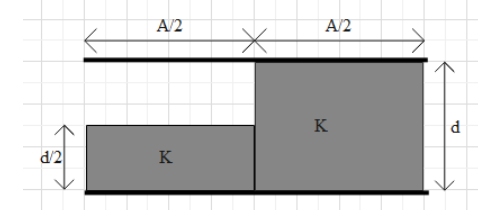Question
Question: A parallel plate capacitor of area ‘A’ plate separation ‘d’ is filled with two dielectrics as shown....
A parallel plate capacitor of area ‘A’ plate separation ‘d’ is filled with two dielectrics as shown. What is the capacitance of the arrangements?

A. 4d3Kε0A
B. 3d4Kε0A
C. 2d(K+1)ε0A
D. 2(K+1)dK(K+3)ε0A
Solution
When a dielectric medium (material) is inserted in between the parallel plates of a capacitance, the capacitor acts as a new capacitor with more capacitance value. i.e. C′=dkε∘A=kC. If there are more than one dielectric materials, each dielectric material acts as a separate capacitor. Then we can convert the dielectrics into capacitors, which makes the work easier. Also, use the formulas for finding the equivalent capacitance when the capacitors are in series and parallel connection.
Formula Used :
C′=dkε∘A=kC
⇒C121=C11+C21
C123=C12+C3
Complete step-by-step answer :
The capacitance of capacitor is given as C=dε∘A , where C is the capacitance of the capacitor, A is area of parallel metal plates, d is the perpendicular distance between the two parallel plates and ε∘ is the permittivity of the free space. This value of capacitance is when there is air in the space between the plates. If there is another medium, which we call as dielectric then the capacitance of the capacitor changes. Dielectric medium is a poor conducting material that creates an internal electric field when an external electric field acts on it.
To understand the new electric field created between the plates after adding the dielectric material, we have something known as dielectric constant (k). k=E′E, where E is the electric field without the dielectric material and E’ is the reduced electric field after inserting the dielectric material. The value of k is always greater than one.
When a dielectric material is inserted in between the parallel plates of the capacitor, the capacitance of the capacitor increases by a factor of K called dielectric constant. Therefore, the new capacitance becomes C′=dkε∘A=kC.
So the dielectric acts as an updated capacitor in the circuit.
Air is also a dielectric medium with dielectric constant equal to 1.
In the given figure, there are three dielectrics. Let the dielectrics be k1, k2 and k3 as shown in the figure below.
If you see the given figure, we can divide it into three different capacitors. Let the capacitance with dielectric constants k1, k2 and k3 be C1, C2 and C3 respectively. Let us now write the expression for each capacitance.
The width of the capacitor (C1) is 2d and the area is 2A, so the capacitance C1=k1(2d)ε∘(2A)=k1dε∘A.
Here k1=1
Therefore, C1=dε∘A ……….(1)
Similarly, the capacitanceC2=k2(2d)ε∘(2A)=k2dε∘A.
And k2=k
Therefore, C2=kdε∘A ……..(2).
The width of the third capacitor (C3) is d and the area is 2A. Therefore, the capacitanceC3=k3dε∘2A=k32dε∘A ……….(3).
And k3=k
Therefore, C3=k2dε∘A.
As we can see that the dielectric with electric constants k1 and k2 are in series and k3 is in parallel with the series connection of k1 and k3. Redraw the figure and replace the dielectrics with their respective capacitance as shown. It will be easier to understand.

The capacitors C1 and C2 are in series. So reciprocal of the effective capacitance (C12) of these two will be the sum of the reciprocals of the two capacitances.
⇒C121=C11+C21. Substitute the values of C1 and C2 from equations (1) and (2).
Therefore, C121=dε∘A1+kdε∘A1=(1+k1)dε∘A1.
⇒C12=(1+k)kdε∘A…….(4)
The capacitor C3 is in parallel with C12. The effective capacitance (C123) of these two will be the sum of the individual capacitance i.e.
C123=C12+C3 .
Substitute the values of C12 and C3 from equations (3) and (4).
C123=(1+k)kdε∘A+k2dε∘A
⇒C123=[(1+k)1+21]dkε∘A
⇒C123=[2(1+k)2+1+k]dkε∘A
Therefore, C123=2(k+1)dk(k+3)ε∘A ……..(5)
Hence, the correct option is (D).
Note :Different materials have different values of dielectric constant. The perfectly conducting materials have the value dielectric constants as infinity (k=∞). A perfectly insulating material has the value of dielectric constant as zero (k=0).
In these types of questions, always remember to convert the dielectrics into capacitors. Then check which are in series and which are in parallel connection and solve accordingly.
